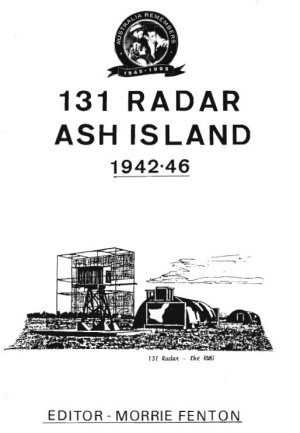
131 RADAR ASH ISLAND 1942 – 1946
The History and Stories of 131 Radar Ash Island 1942-46 – Editor – Morrie Fenton
131 Radar on Ash Island was fairly typical of the small RAAF stations on watch along the east coast of Australia, set up quickly when the threat of enemy action was at its greatest. A very early Ground Control Interception (GCI) unit – formed in 1942 with English mobile equipment and an all male complernent, the station was on watch over Newcastle for several years during which time its equipment was changed twice – finishing its service in 1945/46 with the most modern Canadian GCI set, well protected in an almost impregnable concrete igloo operations room.
More significantly perhaps, in that time the operators’ crews had become almost entirely WAAAF personnel – and the competence and application to duty practised by the girls – and the girls of supporting musterings on the station with them – could be described as a first class example for all radar stations, and to the highest traditions of RAAF Radar.At the same time, there was time for fun, entertainment, relaxation – and even romance – and all these received due mention in the various stories contributed by one-time station personnel. 131 Radar was a small unit of less than fifty. Its history also is small – but all who served on the station can be proud of their essential and careful war-time watch over Newcastle which was then one of Australia’s largest and most vulnerable war equipment factories.
Ground Controlled Interception Radar in the RAAF
The prime purpose of WW II radar was to detect, intercept and hopefully destroy enemy bombers before they reached their target. During the Battle of Britain, interceptions were directed and controlled by the Fighter Sector based on information passed to them by the English Chain Home (CH) and Chain Home flying (CHL) stations with the former giving an estimate of the height of the planes. The English invention of the Plan Position Indicator (PPI) tube led to a new type of radar – the Ground Controlled Interception (GCI) which emerged in December 1940. Operators could obtain grid references of plots direct from the PPI tube. Time was saved because they did not have to calculate the co-ordinates from range and bearing. The introduction of switching the upper and lower parts of the aerial so that they could be fed either in phase or anti-phase created two overlapping lobes in the vertical plane.
A second operator, on the range/height tube, would assess the ratio of the signal strength from one lobe compared with the other, and from calibration charts an estimate of the RAAF radar used three types of GCI sets. The first was an English Mk.V GCI and the aerial and cabin was hand turned by an operator sitting in the cabin and being directed by an operator on the console to turn the aerial left or right via bell signals. For mobility, the first English sets were housed on the back of trucks, while the aerial and cabin were mounted on a trailer. Later the same sets were housed in huts. The second was a Canadian GCI – the RWG was only an acronym to indicate that it was made by the REL Company in Canada. It was a permanent installa¬tion and was a marked improvement for operators as the aerial was electrically turned and controlled from the console, as well as hand controlled by Selsyn motor for greater accuracy when needed. The third type was an Australian made lightweight – LW/GCI – which was a portable unit. These were only stationed in North West Area and Borneo.
The GCI had another advantage, namely, being able to assist friendly aircraft in approaching aerodromes in bad weather – giving them their height and course directions so that they could get do,m safely. It was the forerunner of the Ground Control Approach (GCA) type of radar which was and still is used extensively for civil aviation. At Ash Island, 131 RS was equipped with two of the types mentioned – the first English Mk.V was a mobile station, mounted on 4×4 Crossleys. Afterwards a second Mk.V was installed in huts and the Crossleys then left the island. Then concrete igloos were constructed, and an RWG/GCI was installed. The igloos also were of English design intended originally as underground operations rooms, but in Australia these were mostly built on site in normal fashion, though a few had steps up the tower leading – nowhere. At the time, the Ash Island Gel’s were in the forefront of technology. Wherever Gel’s were stationed, they fulfilled a valuable role in RAAF radar………….
Click here to read the full article in PDF format – article courtesy of http://radarreturns.net.au/
